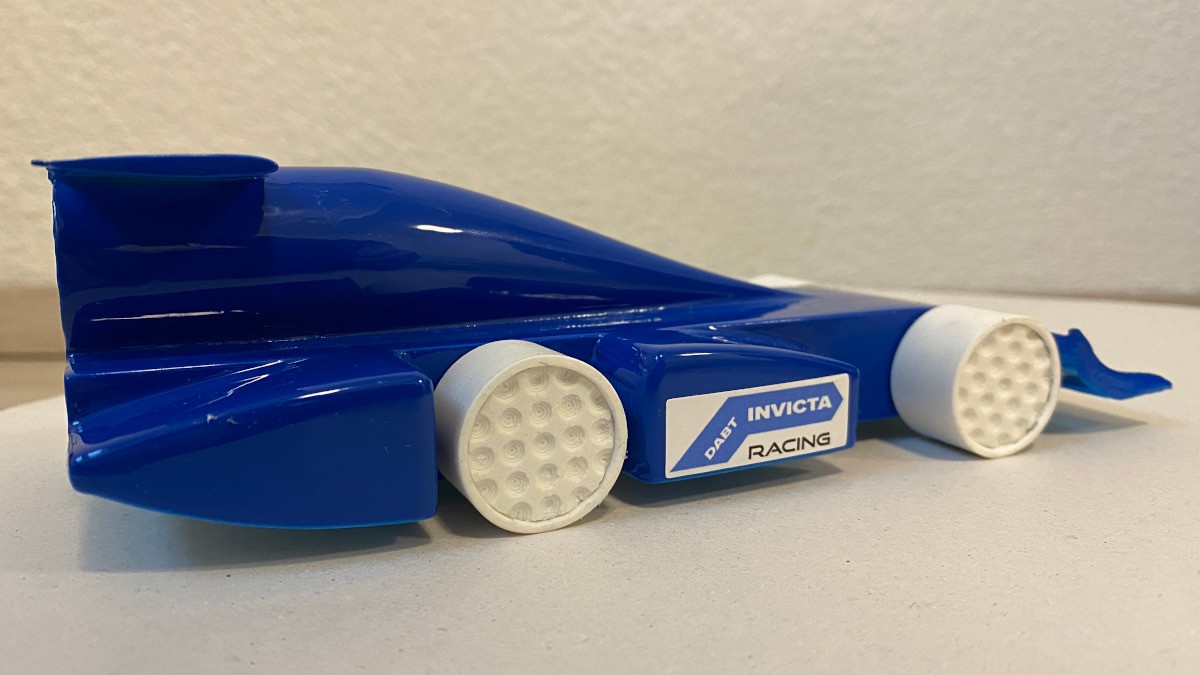
The DABT Invicta Racing Team in the team outfit in front of last year's booth (from left to right): Darien König, Leon Bombach, Niclas Klemm and Yasin Sahiner. Source: Busch Vacuum Solutions.
Formula 1 in Schools
Tense waiting for the signal lamps: Who’s quicker on the trigger? A short hiss sounds and two model cars shoot across the racetrack. That’s “Formula 1 in Schools”, and just like in the real Formula 1, it's all about 100ths of a second. This year, for the second time, a team from Lörrach Technical High School, Germany, is taking part in the competition. The team is supported by Busch Vacuum Solutions.
The goal is to “create an exciting, engaging learning experience to enhance understanding and insight into the fields of product development, technology and science, and to highlight careers in engineering,” states the competition’s website.
First, the students created the technical drawings for the racing cars in CAD (computer-aided design), then printed them with a 3D printer, and finally, used a sandblaster to smoothen the exterior. The final step was to coat the racing bolides with epoxy resin. The racing cars compete against each other on a specially built, horizontal racetrack, which is made of plastic. It is only 20 m long. The racing cars have a length of 19 cm and are powered by a gas cartridge.
“By preparing to take part in ‘Formula 1 in Schools’, we have already been able to gain a lot of practical experience and broaden our horizons in technical and economic terms,” explains Yasin Sahiner, who is responsible for the design drawings in the team. “In addition, the project helps us to orient ourselves with regard to our studies. That’s why participating in the competition is so valuable for us, and we are very happy about the financial support from Busch Vacuum Solutions.”
However, it is not only design and manufacturing as well as reaction time and vehicle speed that determine success in the competition. The students also had to create a timeline, business plan, and presentation, find sponsors and do marketing and media tasks.
The team from Lörrach will compete in the Southern German Championships. They will represent our state at the German championship if they win. 96 teams from 41 schools have registered throughout Germany this school year. The German champion will compete internationally.
Three of the DABT Invicta Racing Team members have chosen “Technology and Management” classes at school as well as one “Mechatronics” class. They can have the project credited as a course for their university entrance qualification.
First, the students created the technical drawings for the racing cars in CAD (computer-aided design), then printed them with a 3D printer, and finally, used a sandblaster to smoothen the exterior. The final step was to coat the racing bolides with epoxy resin. The racing cars compete against each other on a specially built, horizontal racetrack, which is made of plastic. It is only 20 m long. The racing cars have a length of 19 cm and are powered by a gas cartridge.
“By preparing to take part in ‘Formula 1 in Schools’, we have already been able to gain a lot of practical experience and broaden our horizons in technical and economic terms,” explains Yasin Sahiner, who is responsible for the design drawings in the team. “In addition, the project helps us to orient ourselves with regard to our studies. That’s why participating in the competition is so valuable for us, and we are very happy about the financial support from Busch Vacuum Solutions.”
However, it is not only design and manufacturing as well as reaction time and vehicle speed that determine success in the competition. The students also had to create a timeline, business plan, and presentation, find sponsors and do marketing and media tasks.
The team from Lörrach will compete in the Southern German Championships. They will represent our state at the German championship if they win. 96 teams from 41 schools have registered throughout Germany this school year. The German champion will compete internationally.
Three of the DABT Invicta Racing Team members have chosen “Technology and Management” classes at school as well as one “Mechatronics” class. They can have the project credited as a course for their university entrance qualification.
-

The racing car was coated with epoxy resin. Source: DABT Invicta Racing Team.